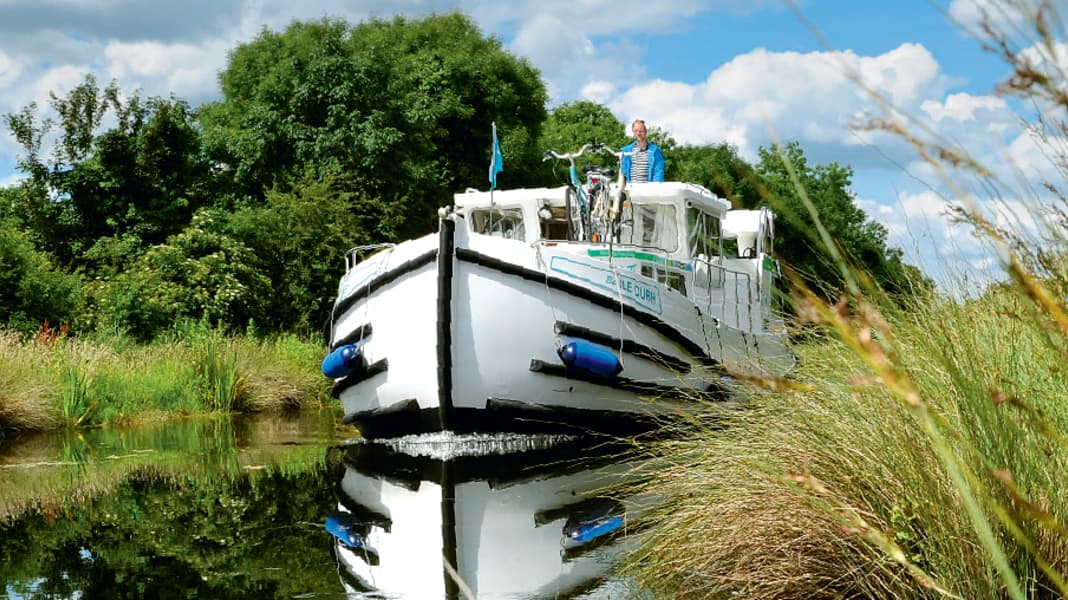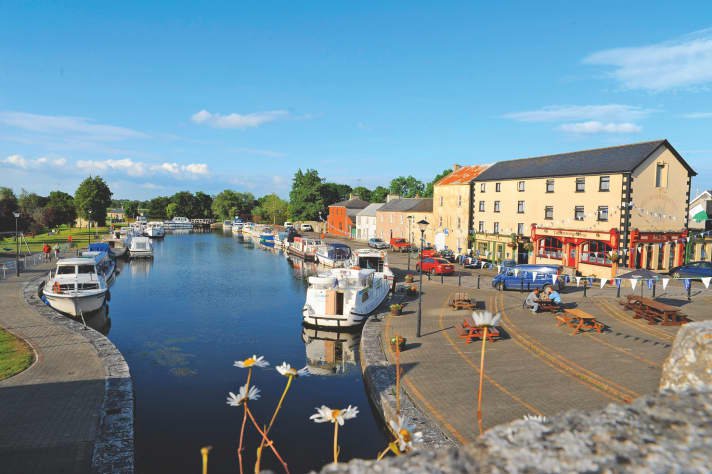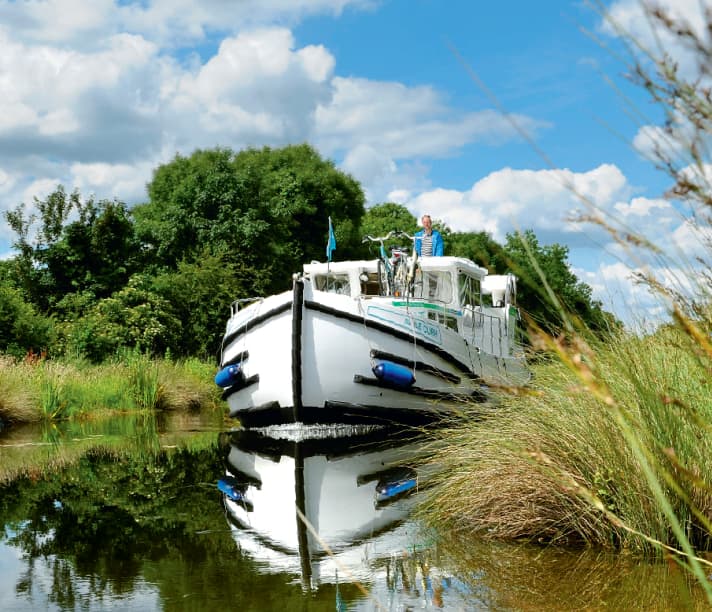Charter and sailing area: Royal Canal in Ireland - Ireland's Green Heart: The Royal Canal
Unbekannt
· 07.08.2015








The moss-green island is said to be the land of monasteries, castles and sheep. Plenty of Guinness and whiskey flow here. At least that's how we had imagined Ireland. The image is true, but that is only half the truth. The other half is made up of the people and their stories, like on the third day of our houseboat tour on the Royal Canal, when we arrive at the lockhouse in Coolnahay.
Claire Christie, a lady in her sixties, invites us into the quaint lock-keeper's cottage - two rooms, each three by four metres
three by four metres, small windows and lots of colourful flowers outside on the garden fence. Her father was already toiling away at the heavy iron cranks of lock number 26, and not much has changed since 1818. Except that today there are only four lock keepers on the 146 kilometre long canal instead of four dozen. Their little houses have fallen into disrepair or been sold as romantic cottages.
The apex of the canal is in Coolnahay. To the east and west, the water runs down into the valley from a nearby reservoir. It would be 96 kilometres to Dublin - four tight sailing days, too much for this one-week trip. Up to this point, we have already covered 20 locks and 50 kilometres since the start at the Locaboat charter base in Cloodara, which we now have to cover again on the way back, and those who make it up to the Christies like us are rewarded with home-baked scones and orange jam at tea time and hear little stories about Irish country life.

The parlour was once the bedroom of mother and daughter, but was also the kitchen. The smoke escaped under the roof - there was no chimney. Claire reports that a dozen farm lads from the neighbourhood came to dance almost every evening. There was always someone at the Christies who played the uillean pipes or the accordion.
"We were destitute, but it was a fun time," Claire remembers. "Do you think the kids next door ever brought anything from their own larder?" At Christmas, there was a bottle of Guinness for the dancing group, "and even that came from us," Claire says with a smile. "You should turn up at the Rustic Inn in Abbeyshrule on a Wednesday night. That's where people meet now. They still make music the way they used to," advises Claire's husband Patrick as they say goodbye.
Since the reopening of the canal in 2010, lock keepers in Waterways Ireland's blue workshop vans have been travelling along the endless cycle and walking paths along the canal banks. Our lock keeper is called Philip Hennessy, just like the cognac, which goes back to an Irishman. Every morning and evening, the 38-year-old gives us a briefing on the upcoming day's stage, which we plan together with him. We meet up to ten times a day at the many locks.

Over time, Phil teaches us how the ancient locks work with their heavy gates. By the way, if you want, you are welcome to do it yourself after a briefing. The fees are included in the charter price.
At the start of the tour in Cloondara, the crew was nervous in one respect: our houseboat, a Pénichette FB 1020, was 3.55 metres wide. However, the usable width of the 46 lock chambers of the Royal Canal is just under four metres - a narrow story. And the numerous old round arch bridges are really exciting: You not only have to watch out for the rubbing strakes on the right and left, but also for the deckhouse of the houseboat, not to mention your own head!
Full concentration is required from the inexperienced; you first have to familiarise yourself with the sluggish movements of the boat. After just one day, however, the small corrections in front of locks, bridges and bends run like clockwork. In the end, the skipper was the most relaxed of all. Sometimes you only really calm down at the helm - and the gentle, green landscape of the Irish Midlands provides active support right from the start.
Almost from the start. At first, huge machines plough through the landscape, leaving a black-brown peat field stretching to the horizon - an open-cast mine the size of a medium-sized airport that reaches right up to the banks of the canal! At least it provides exciting insights. Peat has always been a popular heating fuel in Ireland. The bog, which forms the basis for the peat, was one of the biggest challenges for the engineers when constructing the canal, as a stone bed had to hold the water in the canal. A long search was made for a possible route through the bog, which was up to 20 metres thick.

The first people to roam this treacherous area more than 2000 years ago built a truncated causeway made of oak planks. The moor has preserved this early road. It is on display at the site in the Corlea Trackway Visitor Centre. Why did the Celts want to cross the moor here of all places? The multimedia museum tackles this mystery. It is a quarter of an hour's walk from Mosstown Harbour, a landing stage in the municipality of Keenagh.
From then on, however, the landscape becomes lovelier with every passing hour. Cattle and horses graze in the meadows. We end the first day in Brannighan Harbour after five locks and 23 kilometres. We've only encountered two boats, so it's time for some high life in the pubs of the small town of Ballymahon, which is connected to our mooring via a dirt track.
We finally end up in the Canal Turn. This is where the younger people meet for a beer. We sit at the bar next to Rory, who tells us about blonde women he met as a musician on his tour of Germany. He has fond memories of Germany. The audience was very receptive to his Irish guitar songs and willing to throw a good coin in the hat. He then scribbles a little song on a beer mat: "Music unifies, destiny devides. Loosely translated: "Music brings friends together who are separated by the course of events."

Ballymahon harbour is one of the most beautiful on the canal. The old ticket office of the former canal company has been converted into a meeting place for community groups. Anyone interested in the history of the "resurrection" of the Royal Canal should get in touch with the lockmaster. The veterans of the first hour, who got the idea rolling in the 1960s, like to tell how they were initially ridiculed as fantasists. However, they tell us with a twinkle in their eyes that the constant dripping of water has turned the stone, against all odds: "We achieved so much with so little over such a long period of time that we now feel able to try everything with nothing."
This could yet become important, as the continued maintenance of the canal costs money, and after the banking crisis, budgets were also cut at Waterways Ireland. The bank reeds, for example, are a source of work: they grow into the navigation channel and have to be cut down by the specialised boats that we often see on our tour. What's more, the canal's water supply in this shallow area cannot cope with more than ten boats per day. Perhaps the key to conservation therefore lies in general tourism along the banks of the canal. Anglers, cyclists, horse riders, hikers and nature lovers from Ireland and Great Britain should be able to relax here, and mainland Europeans wouldn't be a bad idea either. Some of them are already here.
Ballymahon and the pretty neighbouring town of Abbeyshrule are a good example of the Midlands' potential: monasteries, castles and the charm of the landscape. Plus visitor magnets such as the Guinness Brewery and the Temple Bar entertainment district in Dublin. With regional public transport, these destinations are also easily accessible from the Royal Canal for those houseboat holidaymakers who can't quite make it to the Irish capital on their cruise.
On our way back, we remember the Christies' recommendation from Lock 26 and moor in Abbeyshrule, an award-winning flower town with only two pubs, about twenty houses and a venerable monastery ruin, but plenty of Irish charm.
The promised evening of music awaits us in the "Rustic Inn", and our lock-keeper couple have not exaggerated. Grandchildren and elderly grandparents sit together and play cheerful folk songs and melancholy ballads late into the evening - songs that everyone here knows: "Rocky Road to Dublin", "Fields of Athenry", "The Auld Triangle". The atmosphere is good and as informal as it can only be in an Irish pub. You quickly strike up a conversation. After all, there's so much to talk about!

The boat
Pénichette 1020 FB: Length 10.20 m, width 3.55 m, two double cabins (one extra bed possible), two heads (shower/WC), two cabins (inside and outside). Bow thruster. Weekly rates: 1085-2100 euros.
The charter company
The company, which is represented throughout EuropeLocaboat operates a base in the village of Cloondara - the first charter service of its kind on the Royal Canal. Due to the narrow bridge crossings, three smaller models of the Pénichette houseboat type are offered for a maximum of seven people. The canal tour can also be planned in addition to a boat holiday lasting several weeks with a trip across the Shannon. For one-way trips, there is another base in Ballinamore on the Shannon-Erne Waterway. Contact: Locaboat Holidays, P.O. Box 867, 79008 Freiburg, Tel. 0761-20 73 70. www.locaboat.com
The channel
The 200-year-old Royal Canal has been navigable again since 2010. It was previously closed for almost 50 years and silted up in places. It is 146 kilometres long. There are 46 manually operated locks to negotiate and the usable dimensions of the chambers are 21 x 3.90 metres. The maximum permitted speed of 6 km/h is quite comfortable. Clearance height: 3.00 m, water depth: 1.20 m. Like the other inland waterways in Ireland, the Royal Canal does not require a licence. Private boats require an annual permit to use the canal (cost: 126 E).
Ports and destinations
The stage plan (see left) is based on seven travelling days. The reverse is in Mullingar. The Royal Canal has only two harbours with services (electricity, water and sanitary facilities), Cloondara and Mullingar. An electronic token with credit for the sanitary blocks is available from Locaboat. For all other moorings, you are dependent on the on-board supply of water and electricity. In principle, you can moor anywhere on the banks of the canal. Both Mullingar and Ballymahon are suitable as a base for excursions into the surrounding area, for example to Athlone and Dublin, or to the whiskey museum in Tullamore. Travelling on to Dublin by water is currently not recommended, but is possible. For the Grand Canal and Shannon, separate, lengthy preparations are necessary, as a railway bridge in Dublin, which only opens once a month, interrupts the waterway. The timetable can be obtained from Waterways Ireland.
Territory guide
Waterways Ireland publishes a detailed "Guide to the Royal Canal" in English. It contains area maps, lock information, guest moorings, service facilities and supply options on land. The 78-page ring binder is available on board the charter boats or can be ordered for €10 from the Waterways Ireland online shop: www.shopwaterwaysireland.org

Cruise stages
Cloondara (Richmond Harbour) ▹ Keenagh (Mosstown Harbour)............. 12 km, 5 locks
Keenagh ▹ Ballymahon (Brannighan Harbour)......................................... 10 km, 2 locks
Ballymahon ▹ Abbeyshrule........................................................................ 7 km, 1 lock
Abbeyshrule ▹ Ballynacargy...................................................................... 8 km, 3 locks
Ballynacargy ▹ Coolnahay Harbour........................................................... 8 km, 3 locks
Coolnahay Harbour ▹ Mullingar................................................................. 9 km, no locks
Total (there and back):............................................................................108 km, 38 locks

